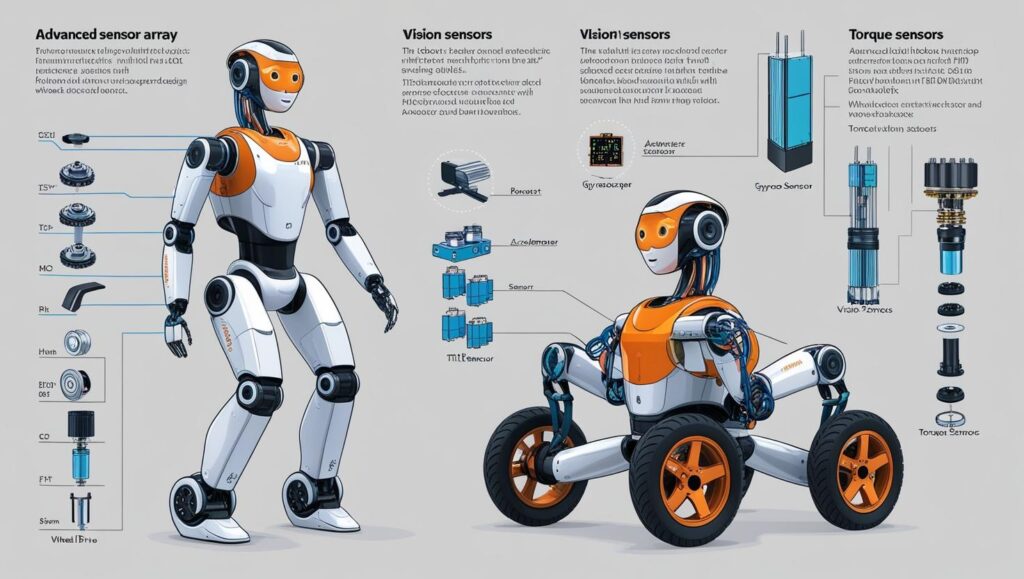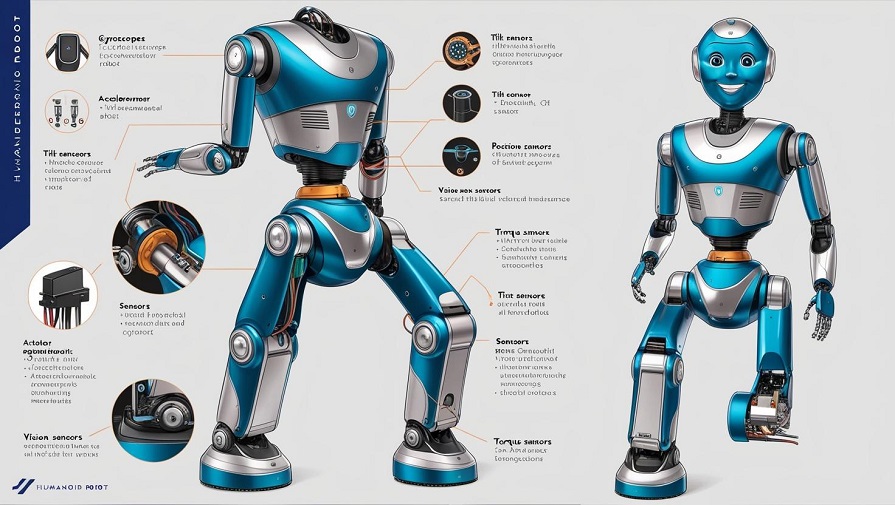The North American humanoid robots market is experiencing a rapid evolution, with humanoid robots being deployed across a diverse range of sectors, particularly healthcare, retail, and manufacturing. The unique ability of humanoid robots to mimic human appearance and behavior makes them highly suitable for tasks traditionally performed by humans. These robots are enhancing productivity, improving customer experiences, and fostering innovation across various industries. As technology continues to evolve, humanoid robots are expected to play a more significant role in reshaping the future of these sectors.
Explores the current state of the North American humanoid robots market, its key drivers, and its transformative impact on healthcare, retail, and manufacturing industries.
1. Introduction to Humanoid Robots
Humanoid robots are machines designed to replicate human form and behavior. They are equipped with sensors, actuators, and advanced artificial intelligence (AI) algorithms to carry out tasks ranging from simple chores to complex operations requiring human-like interaction. With their human-like appearance and behavior, these robots are well-suited for applications that demand a combination of mobility, human interaction, and advanced problem-solving capabilities.
In North America, the humanoid robots market is experiencing considerable growth due to increased demand for automation, improving robotics technology, and higher adoption rates across different industries. Market analysts estimate that the humanoid robots market will continue to expand significantly over the next decade, driven by advancements in robotics, AI, and machine learning.
2. Key Drivers of Market Growth
Several factors contribute to the accelerated growth of the humanoid robots market in North America:
Advancements in Artificial Intelligence and Machine Learning: The rapid development of AI and machine learning technologies is one of the primary factors driving the growth of humanoid robots. These technologies enable robots to learn, adapt, and perform tasks with increasing autonomy. With improved algorithms, humanoid robots are becoming better at problem-solving, real-time decision-making, and recognizing complex patterns.
Increasing Automation Needs: Industries across North America are increasingly adopting automation to reduce human error, improve operational efficiency, and optimize labor costs. Humanoid robots are playing a key role in these automation efforts, particularly in customer service, healthcare, and manufacturing.
Human-Robot Collaboration (HRC): The ability of humanoid robots to collaborate with humans in workplaces is reshaping industries. Robots designed for tasks that require high levels of human interaction and collaboration are essential to improving workplace productivity and employee safety.
Growing Demand for Personalized Services: In sectors like healthcare and retail, personalized experiences are becoming a priority. Humanoid robots, capable of interacting with customers and patients on a personal level, are becoming increasingly valuable in delivering customized services and enhancing customer experiences.
Healthcare and Aging Population: North America is experiencing an aging population, which is driving demand for healthcare robots capable of assisting patients and healthcare professionals. Humanoid robots are being deployed in hospitals and nursing homes to provide support for elderly patients, perform routine tasks, and assist with rehabilitation.
Download PDF Brochure @ https://www.marketsandmarkets.com/pdfdownloadNew.asp?id=99567653

3. Humanoid Robots in Healthcare
The healthcare industry is one of the most promising sectors for humanoid robots. With the rising demand for healthcare services and a shortage of skilled workers, humanoid robots are playing a critical role in addressing staffing shortages and improving the quality of patient care.
Robotic Caregivers and Assistants: Humanoid robots can assist elderly patients or those with disabilities by performing tasks such as reminding them to take medication, assisting with mobility, and monitoring their health status. Robots can also provide companionship to alleviate loneliness, a significant concern among elderly individuals.
Surgical Assistance: In the field of surgery, humanoid robots are beginning to play an essential role. While humanoid robots may not yet perform surgeries autonomously, they assist surgeons in delicate operations by providing enhanced precision and supporting remote surgeries.
Physical Rehabilitation: Some humanoid robots are designed to help patients in rehabilitation settings. They provide support in physical therapy exercises, guiding patients through movements to improve motor functions and coordination.
Healthcare Automation and Patient Interaction: Humanoid robots are used to manage patient records, assist with triaging, or perform basic medical tests. In the future, robots may also be used for telemedicine, allowing healthcare providers to remotely interact with patients, especially in rural or underserved areas.
4. Humanoid Robots in Retail
Retail is another sector where humanoid robots are seeing increased adoption. As customer experience becomes a major competitive factor, humanoid robots are being used to enhance engagement, streamline operations, and improve the overall shopping experience.
Customer Service and Assistance: Retail stores are using humanoid robots to engage with customers, answer questions, and guide them to the products they are looking for. Humanoid robots are able to provide personalized recommendations and act as virtual assistants, improving customer satisfaction.
Inventory Management: Humanoid robots can autonomously scan shelves, track stock levels, and manage inventory. This reduces the need for manual labor and ensures that products are always in stock, helping to improve operational efficiency and reduce costs.
Interactive Shopping Experiences: In retail, humanoid robots are being used to create engaging, futuristic shopping experiences. For instance, robots may greet customers upon entry, offer product demonstrations, or assist with checkout, creating a memorable and interactive experience.
Robots as Marketing Tools: Retailers use humanoid robots as a form of marketing to attract customers. The presence of robots in stores provides an innovative, futuristic ambiance that appeals to tech-savvy consumers, creating excitement and promoting brand awareness.
5. Humanoid Robots in Manufacturing
Manufacturing has been one of the earliest adopters of robotics and automation. Humanoid robots in manufacturing are reshaping the industry by improving safety, productivity, and operational efficiency.
Human-Robot Collaboration (HRC): Collaborative robots, or cobots, which work alongside human workers, are becoming increasingly common in manufacturing plants. Humanoid robots can perform tasks such as assembly, packaging, and quality control, while human workers focus on more complex or value-added tasks.
Precision and Repetitive Tasks: Humanoid robots can perform repetitive tasks with high precision and accuracy. In manufacturing environments, this is beneficial for tasks like part assembly, welding, and painting, where robots can ensure consistent quality and output.
Safety Improvements: Humanoid robots are deployed to perform dangerous or hazardous tasks in manufacturing facilities. This helps to reduce the risk of injury to workers, as robots can handle tasks involving high-risk environments, such as heavy lifting, working with dangerous materials, or operating in extreme temperatures.
Maintenance and Inspection: Humanoid robots can also be used for predictive maintenance and facility inspection. Equipped with sensors and cameras, robots can monitor equipment, detect faults, and perform routine inspections, ensuring that manufacturing processes run smoothly and without interruption.

6. Key Challenges in the Humanoid Robots Market
While the humanoid robots market in North America is expanding, several challenges hinder broader adoption:
High Costs: The development, production, and maintenance costs of humanoid robots are high, making them less accessible to small businesses and certain industries.
Technological Limitations: Despite advancements, humanoid robots are still limited by technology. They are not yet capable of performing all tasks at the same level as humans, and their ability to adapt to complex, unstructured environments remains a challenge.
Ethical and Social Concerns: The introduction of humanoid robots in industries such as healthcare and retail raises ethical questions regarding their role in replacing human workers, especially in sectors already facing labor shortages.
Regulatory Hurdles: Governments must establish clear guidelines and regulations for the safe and ethical use of humanoid robots. This includes addressing issues such as data privacy, safety standards, and integration with existing technologies.
7. The Future of the North American Humanoid Robots Market
Looking ahead, the North American humanoid robots market is poised for continued growth. As AI, robotics, and machine learning technologies continue to evolve, humanoid robots will become increasingly capable of handling more complex tasks across healthcare, retail, and manufacturing. The following trends are likely to shape the future of the industry:
Integration with AI and IoT: Humanoid robots will continue to integrate with AI and IoT systems, creating smarter, more connected devices that can communicate with other machines and human workers in real time.
Increased Personalization: Humanoid robots will become more personalized, capable of adapting to specific customer needs, learning from user behavior, and providing tailored experiences.
Wider Adoption in Small and Medium Enterprises (SMEs): As prices for humanoid robots decrease and technology improves, small and medium-sized enterprises will be able to access robots for various tasks, broadening the scope of automation.
New Applications in Emerging Industries: Humanoid robots will increasingly be used in sectors like education, hospitality, and agriculture, driving innovation and efficiency across diverse industries.
8. Conclusion
The North American humanoid robots companies is growing at an unprecedented pace, with advancements in AI and robotics paving the way for transformative applications in healthcare, retail, and manufacturing. While there are challenges to overcome, such as high costs and technological limitations, the potential benefits of humanoid robots are immense.
With increased automation, improved efficiency, and enhanced customer experiences, humanoid robots are revolutionizing industries and are poised to play an integral role in shaping the future of work and service in North America.
About MarketsandMarkets™
MarketsandMarkets™ is a blue ocean alternative in growth consulting and program management, leveraging a man-machine offering to drive supernormal growth for progressive organizations in the B2B space. We have the widest lens on emerging technologies, making us proficient in co-creating supernormal growth for clients.
The B2B economy is witnessing the emergence of $25 trillion of new revenue streams that are substituting existing revenue streams in this decade alone. We work with clients on growth programs, helping them monetize this $25 trillion opportunity through our service lines – TAM Expansion, Go-to-Market (GTM) Strategy to Execution, Market Share Gain, Account Enablement, and Thought Leadership Marketing.
Built on the ’GIVE Growth’ principle, we work with several Forbes Global 2000 B2B companies – helping them stay relevant in a disruptive ecosystem. Our insights and strategies are molded by our industry experts, cutting-edge AI-powered Market Intelligence Cloud, and years of research. The KnowledgeStore™ (our Market Intelligence Cloud) integrates our research, facilitates an analysis of interconnections through a set of applications, helping clients look at the entire ecosystem and understand the revenue shifts happening in their industry.
To find out more, visit www.MarketsandMarkets™.com or follow us on Twitter, LinkedIn and Facebook.
Contact:
Mr. Rohan Salgarkar
MarketsandMarkets™ INC.
1615 South Congress Ave.
Suite 103
Delray Beach, FL 33445
USA : 1-888-600-6441